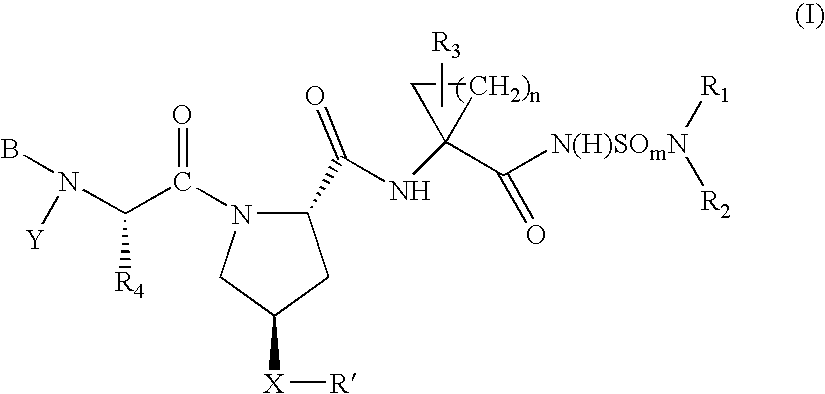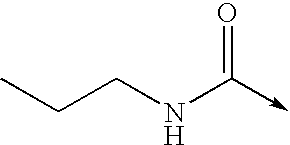Hepatitis C virus inhibitors
a technology of hepatitis c virus and inhibitors, applied in the field of antiviral compounds, can solve the problems of substantial fraction of patients not having a sustained reduction in viral load, and achieve the effect of inhibiting the function of ns3 proteas
- Summary
- Abstract
- Description
- Claims
- Application Information
AI Technical Summary
Benefits of technology
Problems solved by technology
Method used
Image
Examples
example 1
Preparation of 4-(Isoquinolin-1-yloxy)-pyrrolidine-1,2-dicarboxylic acid 1-tert-butyl ester
[0248]
[0249]A suspension of Boc-L-4-hydroxyproline (N-Boc(2S,4R)-hydroxyproline) (3.85 g 16.6 millimole (“mmol”) (CHEM-IMPEX International) in DMSO (60 mL) was cooled in an ice bath for ˜3 minutes, and then t-BuOK (4.66 g, 41.5 mmol) was added. Stirring and cooling in the ice bath was continued for a few minutes until a solid mass formed. At this time the reaction mixture was allowed to warm to rt over 1.5 h to give a clear colorless solution. 1-Chloroisoquinoline (3.0 g, 18.3 mmol) was added in two portions 10 min apart. The reaction was stirred for 24 h at rt. The dark reaction mixture was partitioned between ether (200 mL) and water (600 mL). The aqueous phase was acidified to pH 4 using 4N HCl. The resulting milky yellow solution was extracted with ether (4×200 mL). The combined ether extracts were dried (MgSO4), filtered, and concentrated in vacuo to give a golden oil. Flash chromatograph...
example 2
Preparation of 4-(6-Methoxy-isoquinolin-1-yloxy)-pyrrolidine-1,2-dicarboxylic acid 1-tert-butyl ester
[0250]
Step 1 of Example 2
Preparation of 6-Methoxy-2H-isoquinolin-1-one
[0251]
6-Methoxy-2H-isoquinolin-1-one
[0252]To a solution of 3-methoxy cinnamic acid (11.04 g, 62 mmol), triethylamine (12.52 g, 124 mmol) in acetone (80 mL) was added ethyl chloroformate dropwise at 0° C. After stirring at this temperature for 1 h, aqueous NaN3 (6.40 g, 100 mmol in 35 mL H2O) was added dropwise and the reaction mixture was stirred for 16 h at the ambient temperature. Water (100 mL) was added to the mixture and the volatile was removed in vacuo. The resulting slurry was extracted with toluene (3×50 mL) and the combined organic layers were dried over MgSO4. This dried solution was added dropwise to a heated solution of diphenylmethane (50 mL) and tributylamine (30 mL) at 190° C. The toluene was distilled off as added. After complete addition, the reaction temperature was raised to 210° C. for 2 h. Aft...
example 3
Preparation of P1 Elements for Incorporation Into Compounds of Formula I
I. Preparation of racemic (1R,2S) / (1S,2R)-1-amino-2-vinylcyclopropane carboxylic acid ethyl ester hydrochloride (Method A and Method B)and chiral resolution of this racemate for the preparation of N-(1R,2S)-1-amino-2-vinylcyclopropane carboxylic acid ethyl ester hydrochloride (Method C)
[0258]
[0259]The named compound was made racemic by each of the following methods A and B. This racemate could also be resolved to afford chiral Boc-(1R,2S)-1-amino-2-vinylcyclopropyl carboxylic acid ester which was deprotected under acid conditions to afford (1R,2S)-1-amino-2-vinylcyclopropane carboxylic acid ester hydrochloride (Method C).
Method A
A.1 Preparation of N-Benzyl Imine of Glycine Ethyl Ester
[0260]
[0261]Glycine ethyl ester hydrochloride (303.8 g, 2.16 mole) was suspended in tert-butylmethyl ether (1.6 L). Benzaldehyde (231 g, 2.16 mole) and anhydrous sodium sulfate (154.6 g, 1.09 mole) were added and the mixture cooled ...
PUM
| Property | Measurement | Unit |
|---|---|---|
| temperature | aaaaa | aaaaa |
| temperature | aaaaa | aaaaa |
| temperature | aaaaa | aaaaa |
Abstract
Description
Claims
Application Information
 Login to View More
Login to View More - R&D
- Intellectual Property
- Life Sciences
- Materials
- Tech Scout
- Unparalleled Data Quality
- Higher Quality Content
- 60% Fewer Hallucinations
Browse by: Latest US Patents, China's latest patents, Technical Efficacy Thesaurus, Application Domain, Technology Topic, Popular Technical Reports.
© 2025 PatSnap. All rights reserved.Legal|Privacy policy|Modern Slavery Act Transparency Statement|Sitemap|About US| Contact US: help@patsnap.com



